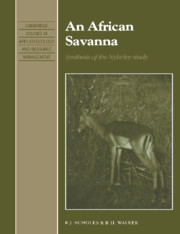Book contents
- Frontmatter
- Contents
- Preface
- I Nylsvley in an African savanna context
- II The key determinants: water, nutrients, fire and herbivory
- III The carbon cycle
- IV Community and landscape pattern and change
- 12 Rich savanna, poor savanna
- 13 Community structure, composition and dynamics
- 14 Tree–grass interactions
- 15 Plant–herbivore interactions
- Part V Lessons from Nylsvley
- Bibliography
- Index
15 - Plant–herbivore interactions
Published online by Cambridge University Press: 06 October 2009
- Frontmatter
- Contents
- Preface
- I Nylsvley in an African savanna context
- II The key determinants: water, nutrients, fire and herbivory
- III The carbon cycle
- IV Community and landscape pattern and change
- 12 Rich savanna, poor savanna
- 13 Community structure, composition and dynamics
- 14 Tree–grass interactions
- 15 Plant–herbivore interactions
- Part V Lessons from Nylsvley
- Bibliography
- Index
Summary
The plants and herbivores of African savannas have coexisted for millions of years. This, and the rich variety of organisms occurring in savannas, makes them an ideal laboratory for examining plant-animal interactions. Trees, forbs and grasses have evolved different modes of defence against herbivory, and browsers and grazers have different approaches to overcoming them. Mammalian and insect herbivory have elicited different responses in plants, and there are many variations within each group. There are characteristic differences in the type and degree of herbivory on nutrient-rich versus nutrient-poor sites, and the method of defence adjusts accordingly. The Nylsvley study provided opportunities for examining all these issues.
This chapter should be read as a companion to Chapter 9, on herbivory. That chapter took an ecosystem-level view of the degree and type of herbivory, and its impact on savanna function. This chapter concentrates on individual species, and asks the question: why are some plants eaten, and others not?
This question has major implications for the livestock industry. In Chapter 9 it has been shown that only a small portion of the aboveground primary production is converted into secondary production. This is largely because much of the plant material on offer is unacceptable to animals. As the livestock industry moves towards more complete use of the savanna resource, especially through the incorporation of browsers in the production system and the trend towards multispecies stocking, it is crucial to know what controls the plant–herbivore interaction.
- Type
- Chapter
- Information
- An African SavannaSynthesis of the Nylsvley Study, pp. 230 - 248Publisher: Cambridge University PressPrint publication year: 1993



